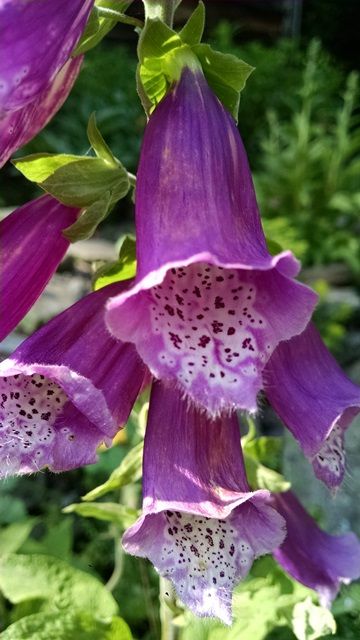
The foxglove, a favorite Catskills flower, is now blooming. Some people think that it is a wildflower, because they see it growing in uncultivated ground. But those foxgloves are actually naturalized, having escaped from gardens and spread into the wild (see first picture below). They spread by generating copious quantities of minute seed. They are vigorous plants, and are popular for their tall spikes of (usually) dark pink flowers. There is some variation with paler to white forms found.The common garden foxglove is known to botanists as the species Digitalis purpurea. It is a native of Europe. Like the other 20 species in the genus, it prefers acidic soil and eschews full sun, doing quite well in shadier situations like the dappled shade of the woodland’s edge. Most varieties commercially available are selected from or hybridized from this species.
Another occasionally available species of foxglove from Europe is Digitalis lutea, the yellow foxglove (also pictured below). It is daintier and less forgiving of the hot sun than the D. purpurea. It has pale yellow flowers and shiny dark green leaves.
All parts of the foxglove plant are poisonous if ingested, but the chemical that makes it poisonous is the same that in minute quantities, has pharmacological properties. The chemical is called digitalin and it has a very long history of medicinal use, primarily to help stimulate and control the heartbeat.
Digitalis flowers are designed to be pollinated by bumble bees. The spotted pattern inside the flower provides the bee with landing directions, and the flower’s tube is just large enough for the bumble bee to enter the flower and reap its reward of pollen (see picture above). The flowers open in order from the bottom of the flower spike to the top. When the flower first opens, the female parts of the flower are receptive to pollen, but as the flower ages, the female stigma part becomes unreceptive to the pollen and the male flower parts release their pollen. The bumble bee searches for pollen starting with the bottommost flowers and works its way up the flower spike. The pollen from the previously foraged plant is rubbed onto the sticky stigmas of the lower flowers and the pollen from the upper flowers is collected by the bee, who will then fly off to forage on another flower spike.
To see what From Root to Shoot can do for your garden, check out Root's website!



